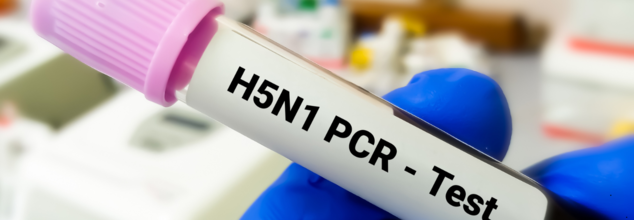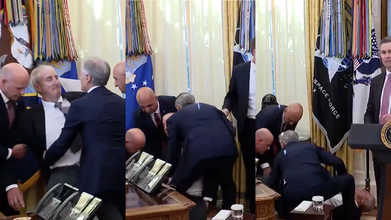- Health Conditions A-Z
- Health & Wellness
- Nutrition
- Fitness
- Health News
- Ayurveda
- Videos
- Medicine A-Z
- Parenting
- Web Stories
The US Reports A Rare Case Of Bird Flu, CDC Notes Change In Infection Pattern

Amid rising cases of mpox and other viruses, a Missouri resident is reported to have the bird flu. This is the first person in the United States to come into contact with avian influenza or bird flu. However, the person has not have any exposure to infected animals, confirmed the authorities.
This case was confirmed on Friday, which marks a significant shift in the patterns of infection. It is a rare case as the infection did not happen due to exposure. Previously, all such cases in the US involved contact with farm animals or contaminated environment.
The current patient has a pre-existing health condition and was hospitalised on August 22 after testing positive for a suspicious strain of flu.
How Is It Being Treated?
According to the Centers for Disease Control and Prevention (CDC) and the Missouri Department of Health and Senior Services, the person was treated with antiviral medication and was discharged after making a full discovery.
Testing
The initial test indicated an unusual flu strain that got the state and federal laboratories to get involved. The later tests confirmed the presence of H5 virus, or known as the avian or bird flu.
There are a total of 14 cases of bird flu in the US this year. However, this is the first case of human infection without direct exposure to animals.
Missouri health officials also noted that no H5 infections have been reported in dairy cattle within the state, except in wild birds and among commercial and backyard poultry flocks.
Does It Come From Other Animals?
Bird flu primarily infected farmworkers or those in close proximity to livestock. The first human bird flu case in the US was reported in 2022, to a person who was also involved in farm-working.
While this flu is largely confined to birds in the wild and poultry, recent outbreaks have been reported in mammals too, including cattle.
While 14 cases are in the US, the CDC notes that the risk to the general public is still at low, however, this warning could change. "Although human infections are rare, circumstances may evolve as we learn more about this case," said the CDC in a statement.
Mounjaro Becomes India’s Top-Selling Medicine in October; What’s Driving The Surge

Credits: Canva
Eli Lilly’s weight-loss and diabetes injection, Mounjaro, has overtaken GSK’s antibiotic Augmentin (GSK.L) to become India’s highest-selling drug by value in October, as demand for weight-loss treatments continues to surge in the world’s most populated country. According to new data from research firm Pharmarack, the U.S.-based drugmaker’s popular injectable earned ₹1 billion ($11.38 million) in sales last month, compared to Augmentin’s ₹800 million.
While Augmentin still led in overall units sold—5.8 million doses versus 85,000 of Mounjaro—the latter’s premium pricing pushed it ahead in total value, as per Reuters. Analysts say India is rapidly emerging as a major market for obesity treatments, with the global weight-loss drug sector expected to cross $150 billion annually by the end of this decade.
Eli Lilly’s Mounjaro Becomes India’s Top-Selling Medicine in October
Launched in India in March 2025, Mounjaro which helps regulate blood sugar levels and reduces appetite—has seen its sales double within months, surpassing its rival Wegovy by Novo Nordisk, which entered the Indian market in June. Data from Pharmarack shows that Mounjaro has so far generated ₹3.33 billion in total revenue.
“Mounjaro’s consumption in India by volume was nearly ten times higher than Wegovy in October,” said Sheetal Sapale, Vice President (Commercial) at Pharmarack. Eli Lilly sold around 262,000 doses of Mounjaro last month, compared to 26,000 doses of Wegovy. Both drugs belong to the GLP-1 receptor agonist class, designed to treat obesity and type 2 diabetes.
How Does Mounjaro Work?
Mounjaro is a once-weekly injectable medication developed primarily for managing type 2 diabetes. Its key ingredient, tirzepatide, is the first of its kind to act on two gut hormones—GLP-1 (glucagon-like peptide-1) and GIP (glucose-dependent insulinotropic polypeptide). This dual mechanism makes Mounjaro more advanced than older drugs such as Ozempic (semaglutide) or Victoza (liraglutide), which target only GLP-1, which is thus driving a surge in its sale in india.
Although it was originally approved for diabetes management, Mounjaro has attracted global attention for its strong weight-loss effects. Ongoing studies are evaluating its use for non-diabetic individuals struggling with obesity. The drug mimics the action of GIP and GLP-1, which are hormones released naturally after meals to regulate insulin release, lower blood sugar, and suppress appetite.
Mounjaro for Type 2 Diabetes
For people living with type 2 diabetes, keeping blood sugar in check often requires a combination of medicines, diet adjustments, and regular monitoring. Mounjaro offers a more integrated solution by targeting multiple factors that influence glucose levels. Findings from clinical trials, including the SURPASS-1 to SURPASS-5 studies, show that Mounjaro delivers better outcomes than many existing diabetes treatments, particularly in lowering HbA1c levels—a key marker of long-term glucose control.
Patients using Mounjaro have shown:
- Lower fasting and post-meal blood sugar levels
- Reductions in HbA1c by up to 2.5%
- Improved insulin sensitivity
Mounjaro and Weight Loss
Beyond its use for diabetes, Mounjaro has gained global popularity for its significant role in weight reduction. Clinical studies reveal that people taking the drug often lose between 15% and 20% of their body weight over several months of consistent use. This level of weight loss surpasses that seen with many earlier treatments and even some surgical interventions, making Mounjaro one of the most effective options currently available for managing obesity.
Disclaimer: This article is intended for general information and should not replace professional medical guidance. Always consult your doctor for advice or concerns regarding any health condition.
Trump Administration May Deny Visas To Obese, Diabetic Immigrants: What We Know So Far

Credits: CANVA
Following the sharp hike in the H-1B visa fee to $100,000, the Trump administration may soon begin rejecting visa applications from foreigners with certain health conditions, including diabetes and obesity.
While there has been no formal confirmation from U.S. authorities, a report by KFF Health News said a cable from the State Department to embassies and consulates listed new health-related grounds for visa denials.
Trump May Now Deny Entry to Diabetic and Obese Immigrants
According to the report, the guidance instructs visa officers to consider applicants ineligible for entry based on factors such as age and medical conditions, including cardiovascular and respiratory diseases, cancer, diabetes, metabolic and neurological disorders, and certain mental health conditions.
Officers have also been told to evaluate other issues such as obesity — which can contribute to high blood pressure, asthma, and sleep apnea, when assessing whether an applicant might become a “public charge,” or a potential financial burden on the U.S. government.
The guidance further directs officials to determine whether the applicant has sufficient financial resources to pay for their care. “Does the applicant have adequate financial resources to cover the costs of such care over his entire expected lifespan without seeking public cash assistance or long-term institutionalization at government expense?” the cable states.
It adds that individuals who could become a “public charge” — due to age or chronic health problems, may be denied entry for potentially relying on U.S. public resources.
Although the directive applies broadly to most visa categories, it is expected to primarily impact those applying for permanent residency, senior attorney Charles Wheeler told KFF Health News.
Can US Officers Reject Visas Over Health Or Financial Ability?
Visa officers have also been instructed to evaluate whether applicants can afford medical treatment independently, without relying on U.S. public funds.
Wheeler said the new rule gives officers the power to form their own opinions on what might lead to future medical emergencies or financial strain. “That’s concerning because these officers are not medically trained, have no expertise in this area, and should not be making projections based on personal judgment or bias,” Wheeler said.
US Visa Officers To Consider Health Of Applicants’ Family Members
The cable also instructs visa officers to assess the health of applicants’ family members — including children or elderly parents, when determining visa eligibility.
“Do any of the dependents have disabilities, chronic medical conditions, or other special needs and require care such that the applicant cannot maintain employment?” the State Department communication asks.
Currently, immigrant applicants must undergo a medical examination conducted by a doctor approved by the U.S. embassy. The screening includes tests for infectious diseases, an evaluation of mental health history, substance use, and proof of vaccination against illnesses such as measles, polio, and hepatitis B.
However, immigration lawyer Sophia Genovese from Georgetown University noted that the new guidance expands these requirements by directing officials to weigh long-term health conditions, not just communicable diseases, when reviewing visa applications.
Fact Check: Did Novo Nordisk Executive Faint In Oval Office? Here's What Actually Happened

Credits: X
While TrumpRx is making headlines for lowering the prices of popular weight loss drugs, something else has also grabbed attention of many. A video from the Oval Office from the Thursday Press Conference when President Donald Trump was announcing the deal with the drugmakers, a man had collapsed. Many claimed that the person who collapsed was Gordon Findlay, who is Novo Nordisk's executive. Dr Mehmet Oz, an American present and a physician was swift to check on the man who had collapsed. Independent journalist Eric Daugherty shared the video and wrote: "A man just passed out during President Trump's Oval Office announcement. Dr Oz Sprung into action and assisted him. Pray for him."
Also Read: TrumpRx: Will Trump’s New Website Make Prescription Drugs More Affordable?
Is The Man Gordon Findlay?
The reason why many have identified the man as Gordon Findlay because in the video, David Ricks, CEO of Eli Lily could be heard asking, "You okay? Gordon, you okay?" Upon this, the White House Press Secretary Karoline Leavitt said in the statement that "a representative with one of the companies fainted". However, no names were given.
Novo Nordisk later clarified the claims, and in a statement to Newsweek, the company said, "Please be aware that CEO Mike Doustdar and EVP, US operations, Dave More were the only two Novo Nordisk representatives in the Oval Office."
Dr Oz had previously also helped out at the Oval office in April, when a child fainted while he was being sworn in. A woman, who many media outlets claimed, appeared to be Oz's daughter, Daphne, escorted the girl who had fainted. Later, the White House official confirmed to Fox News Digital that the girl was family member of Oz and had recovered.
What To Do When Someone Collapses?
If someone collapses in front of you, the first need is for someone to try simple CPR or cardiopulmonary resuscitation, while medical help is on its way. What must one keep in mind if someone collapses?
Check for any danger around the person, and give the shoulders of the person who collapsed a shake. Ask them if they can hear you, notes BBC.
If there is no response, tilt their head back to ensure that the airway is clear. This may be enough for the person to again start breathing.
If they are not breathing, this is when CPR becomes important.
Also Read: Trump Strikes Agreement To Cut Costs of Popular Weight Loss Drugs: All You Need to Know
How To Do CPR The Right Way?
As per NHS, UK, there are two correct ways to practice CPR on adults:
Hands-only CPR
This is to be carry out as a chest compression
- Start with kneeling next to the person and place the heel of your hand on the breastbone at the centre of their chest. Place the palm of your other hand on top of the hand that is on their chest and interlock your fingers.
- Position yourself so your shoulders are directly above your hands.
- Using your body weight (not just your arms), press straight down by 5 to 6cm (2 to 2.5 inches) on their chest.
- Keeping your hands on their chest, release the compression and allow their chest to return to its original position.
- Repeat these compressions at a rate of 100 to 120 times a minute until an ambulance arrives or for as long as you can.
CPR with rescue breaths
- Place the heel of your hand on the center of the person's chest, then place the palm of your other hand on top and press down by 5 to 6cm (2 to 2.5 inches) at a steady rate of 100 to 120 compressions a minute.
- After every 30 chest compressions, give 2 rescue breaths.
- Tilt the person's head gently and lift the chin up with 2 fingers. Pinch the person's nose. Seal your mouth over their mouth and blow steadily and firmly into their mouth for about 1 second. Check that their chest rises. Give 2 rescue breaths.
- Continue with cycles of 30 chest compressions and 2 rescue breaths until they begin to recover or emergency help arrives.
© 2024 Bennett, Coleman & Company Limited

